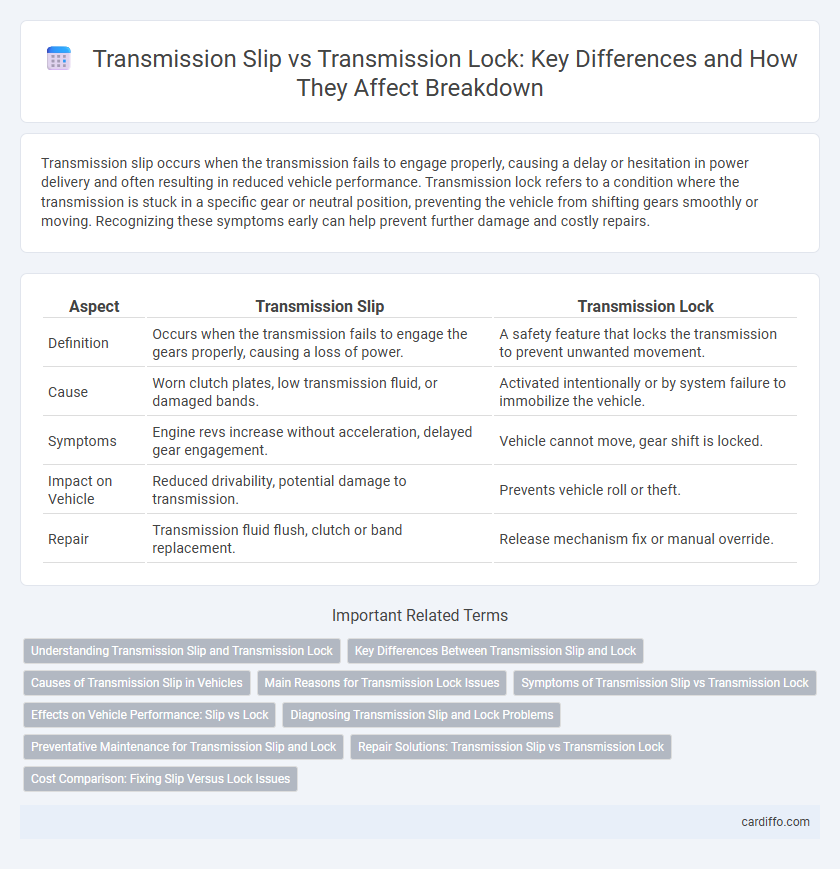Transmission slip occurs when the transmission fails to engage properly, causing a delay or hesitation in power delivery and often resulting in reduced vehicle performance. Transmission lock refers to a condition where the transmission is stuck in a specific gear or neutral position, preventing the vehicle from shifting gears smoothly or moving. Recognizing these symptoms early can help prevent further damage and costly repairs.
Table of Comparison
| Aspect | Transmission Slip | Transmission Lock |
|---|---|---|
| Definition | Occurs when the transmission fails to engage the gears properly, causing a loss of power. | A safety feature that locks the transmission to prevent unwanted movement. |
| Cause | Worn clutch plates, low transmission fluid, or damaged bands. | Activated intentionally or by system failure to immobilize the vehicle. |
| Symptoms | Engine revs increase without acceleration, delayed gear engagement. | Vehicle cannot move, gear shift is locked. |
| Impact on Vehicle | Reduced drivability, potential damage to transmission. | Prevents vehicle roll or theft. |
| Repair | Transmission fluid flush, clutch or band replacement. | Release mechanism fix or manual override. |
Understanding Transmission Slip and Transmission Lock
Transmission slip occurs when the transmission's input and output shafts rotate at different speeds, causing a loss of power and affecting vehicle performance, often due to worn clutches or fluid issues. Transmission lock refers to a condition where the transmission fails to disengage properly, resulting in the vehicle being stuck in a gear, commonly caused by mechanical failure or shift linkage problems. Understanding transmission slip and lock is crucial for diagnosing drivability issues and preventing further damage to the transmission system.
Key Differences Between Transmission Slip and Lock
Transmission slip occurs when the clutch or friction components fail to engage properly, causing delayed or inconsistent gear shifts and loss of power transfer. Transmission lock, on the other hand, is a mechanical failure where the gears seize or jam, preventing any movement or gear changes altogether. The key difference lies in slip causing gradual loss of transmission efficiency, while lock results in complete immobilization of the drivetrain.
Causes of Transmission Slip in Vehicles
Transmission slip in vehicles is primarily caused by worn or damaged clutch plates, low transmission fluid levels, and degraded fluid quality leading to inadequate hydraulic pressure. Faulty torque converters and malfunctioning shift solenoids also contribute to inconsistent gear engagement and slipping. Regular maintenance and timely fluid replacement are essential to prevent transmission slip and ensure smooth vehicle operation.
Main Reasons for Transmission Lock Issues
Transmission lock issues commonly result from low transmission fluid levels, which cause insufficient lubrication and overheating. Worn or damaged internal components such as clutches and bands can also trigger locking problems by preventing proper gear engagement. Faulty solenoids and sensor malfunctions disrupt hydraulic pressure and signal flow, leading to transmission lock failures.
Symptoms of Transmission Slip vs Transmission Lock
Transmission slip symptoms include delayed acceleration, engine revving without corresponding vehicle speed, and erratic shifting patterns. Transmission lock symptoms often manifest as the vehicle refusing to move in certain gears, sudden jerking, or an audible grinding noise during gear engagement. Both issues indicate underlying transmission problems requiring prompt diagnosis to prevent further damage.
Effects on Vehicle Performance: Slip vs Lock
Transmission slip causes delayed acceleration and reduced power delivery, leading to inefficient vehicle performance and increased fuel consumption. Transmission lock results in a complete loss of gear engagement, causing the vehicle to lose mobility and potentially damaging the drivetrain. Both conditions degrade drivability, but slip allows limited motion while lock halts movement entirely.
Diagnosing Transmission Slip and Lock Problems
Diagnosing transmission slip involves checking for worn clutch plates, low transmission fluid levels, and faulty solenoids that cause delayed or erratic gear changes. Transmission lock issues require inspecting the shift linkage for damage, ensuring the transmission control module is functioning properly, and ruling out mechanical failures such as broken gears or seized components. Accurate diagnosis often combines scanning for diagnostic trouble codes (DTCs) with a physical inspection of hydraulic pressure and fluid condition to identify the root cause.
Preventative Maintenance for Transmission Slip and Lock
Transmission slip occurs when the transmission fails to engage properly, causing delayed or erratic vehicle response, while transmission lock results in the transmission becoming stuck in a gear or neutral. Preventative maintenance for transmission slip and lock includes regular fluid checks and changes using manufacturer-recommended transmission fluid, inspecting and replacing worn clutch plates or bands, and ensuring the transmission control module functions correctly. Monitoring for early signs such as gear slipping, delayed shifting, or unusual noises can prevent costly repairs and enhance transmission longevity.
Repair Solutions: Transmission Slip vs Transmission Lock
Transmission slip occurs when the transmission fails to engage gears properly, causing delayed acceleration or erratic shifting, which often requires clutch adjustment, fluid replacement, or solenoid repair. Transmission lock happens when the transmission becomes stuck in a gear or neutral position, typically caused by severe mechanical wear or electronic control failure, necessitating diagnostic testing, component replacement, or complete transmission rebuild. Repair solutions vary based on the root cause; technicians use scan tools to identify error codes for lock issues, while slip problems often respond to fluid maintenance and minor part replacement.
Cost Comparison: Fixing Slip Versus Lock Issues
Transmission slip repairs typically cost between $500 and $1,500, depending on the severity and required parts, while transmission lock issues often demand more extensive work, ranging from $1,000 to $3,000. Slip problems usually involve fluid leaks or worn clutches, making them less expensive to fix compared to lock issues, which often require replacing complex components like the torque converter or valve body. Choosing timely repairs can significantly reduce overall expenses and prevent further damage to the transmission system.
Transmission slip vs transmission lock Infographic

 cardiffo.com
cardiffo.com